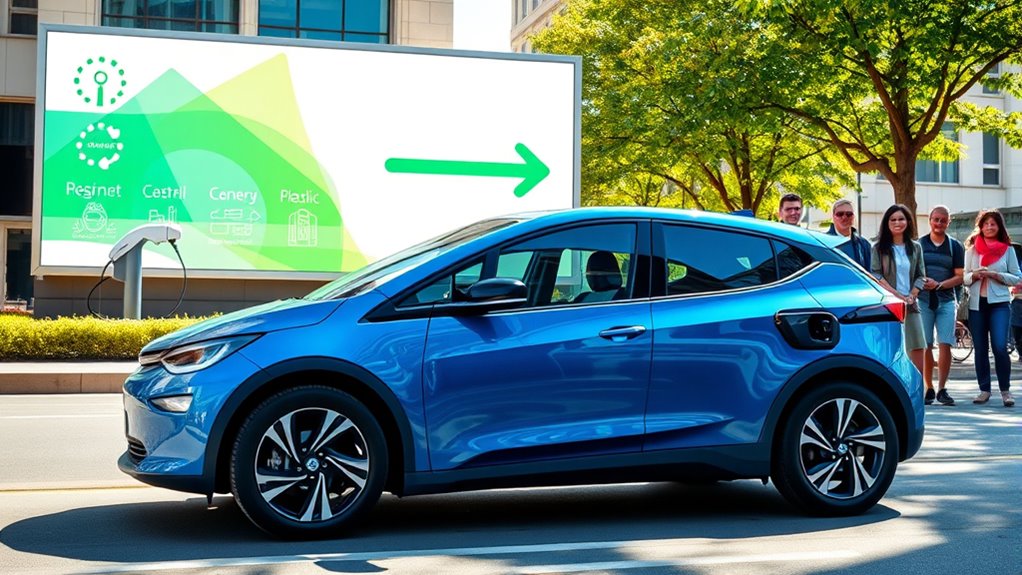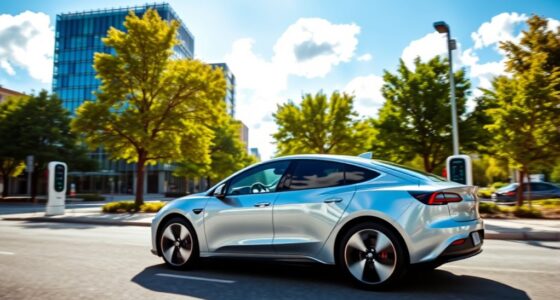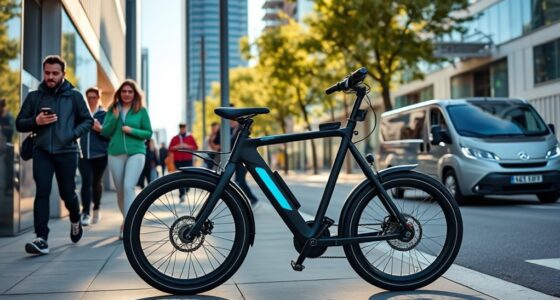Government incentives make buying electric vehicles more affordable by offering federal tax credits up to $7,500 for new EVs and smaller credits for used models, depending on sourcing and assembly. Many states and utilities also provide rebates, discounts, and perks like HOV lane access. Leasing and commercial EVs have special incentives, too. Keep in mind, policies may change, so exploring current eligibility details can help you maximize your benefits. Stay tuned for more insights on how you can save with EV incentives.
Key Takeaways
- Federal tax credits up to $7,500 are available for new EVs, with eligibility based on vehicle assembly, battery sourcing, and price limits.
- Used EVs can qualify for up to $4,000 or 30% of the purchase price if they are at least 2 years old and under $25,000.
- State and utility programs offer additional rebates, discounts, and incentives for EV purchases, charging equipment, and infrastructure.
- Leasing EVs typically do not qualify for federal purchase credits; leasing companies may claim a commercial credit instead.
- Future incentives depend on legislative changes; staying informed through official government resources is essential.
Overview of Federal Incentives for EV Buyers
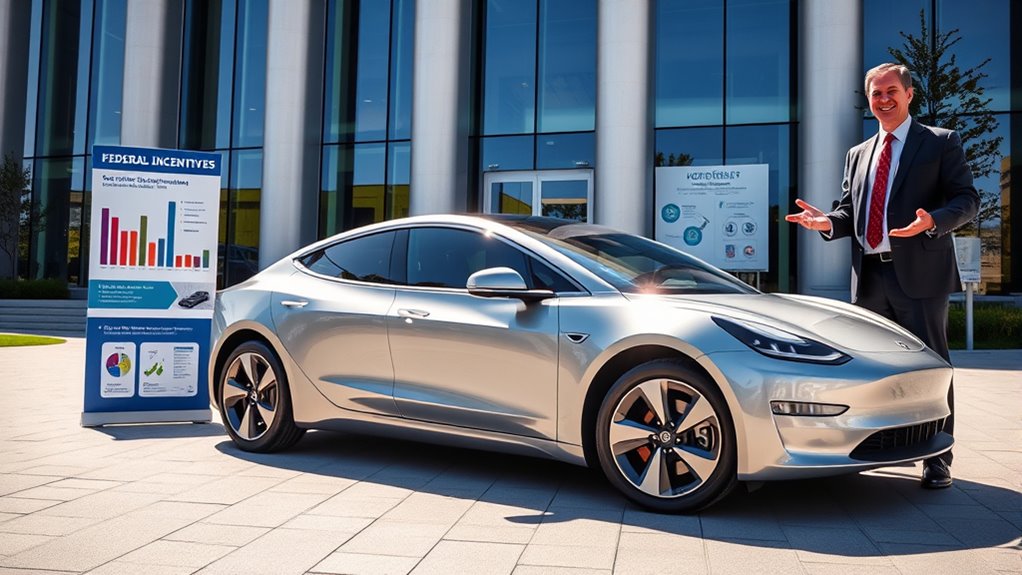
Are you aware of the federal incentives available for electric vehicle buyers? The government offers federal tax credits that can reduce your purchase costs appreciably. For new Electric Vehicles, you might qualify for up to a $7,500 credit, depending on vehicle assembly, battery sourcing, and purchase price. To claim the full tax credit, your vehicle must meet specific requirements, including North American final assembly, verified through VIN checks. Income limits apply—$300,000 for joint filers, $225,000 for heads of households, and $150,000 for individuals. Understanding vehicle eligibility criteria can help you determine if your chosen EV qualifies for the incentive. Additionally, staying informed about automaker compliance ensures you are aware of recent updates to incentive eligibility. Regular updates to AI security measures can help protect your personal information during the application process. Being aware of the growing availability of used EVs is also beneficial, as the used market increasingly offers more affordable options that still qualify for incentives. Used EVs also qualify, with a maximum credit of $4,000 or 30% of the purchase price, whichever is lower, applicable to vehicles at least two years old and costing under $25,000. You’ll file IRS Form 8936 to claim your credit or transfer it directly to dealers for immediate savings.
Understanding State and Local Support Programs

- Rebate programs like California’s $2,000 rebate and Colorado’s $4,000 incentives
- Utility rebates for charging equipment and discounted electricity rates
- Benefits like HOV lane access, free or discounted parking, and vehicle inspection exemptions
Keep in mind that these incentives are often time-limited offers and region-specific. To maximize benefits, you should verify current eligibility, understand the application procedures, and stay updated on regional support programs through official state and utility websites.
Eligibility Criteria for the Federal Tax Credit
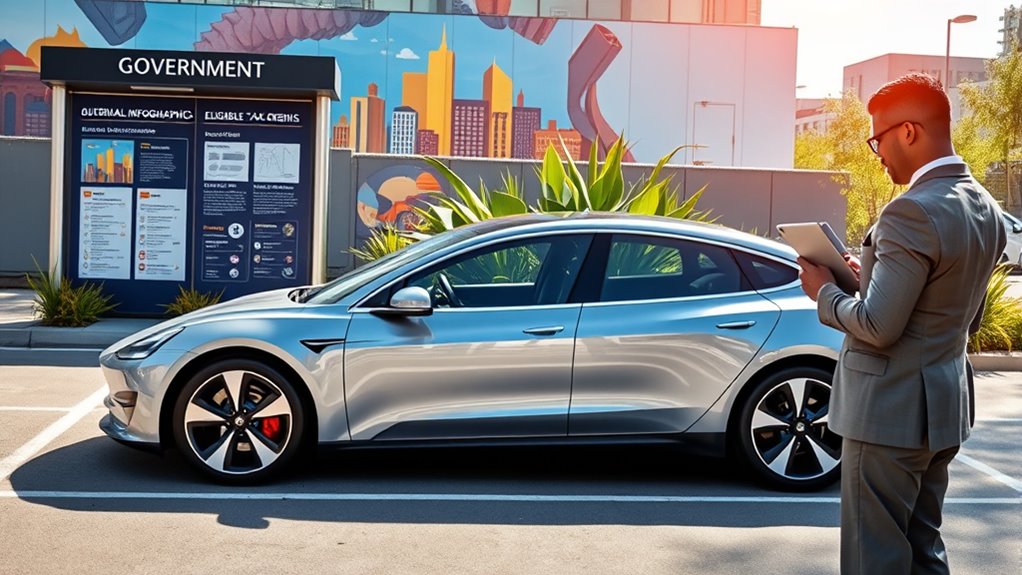
To take advantage of the federal EV tax credit, you need to make certain your vehicle meets specific eligibility criteria. Qualified vehicles must be newly purchased and have a model year of 2025 or later. The vehicle’s price must fall within the set price caps—$80,000 for trucks, SUVs, and vans, and $55,000 for sedans. You’ll need to verify the vehicle’s eligibility through its Vehicle Identification Number (VIN) and ensure it meets manufacturer requirements, including final assembly in North America. Battery sourcing is also critical; at least 50% of battery components must be produced or assembled in North America, with minerals sourced from approved regions. Battery sourcing is essential for eligibility; understanding the supply chain helps buyers make informed choices. The Department of Energy’s battery supply chain initiatives aim to bolster domestic manufacturing and secure critical materials. Additionally, advancements in electric vehicle technology contribute to increased efficiency and range, making EVs more attractive to consumers. Incorporating green energy solutions into the manufacturing process can further enhance the sustainability of electric vehicles and their supply chains. Income limits apply, capped at $300,000 for joint filers, $225,000 for heads of household, and $150,000 for individuals, affecting eligibility for the full credit. Additionally, understanding emotional support is essential for buyers navigating the transition to electric vehicles, especially as they adapt to new technologies and lifestyle changes.
How to Claim and Maximize Your Incentives
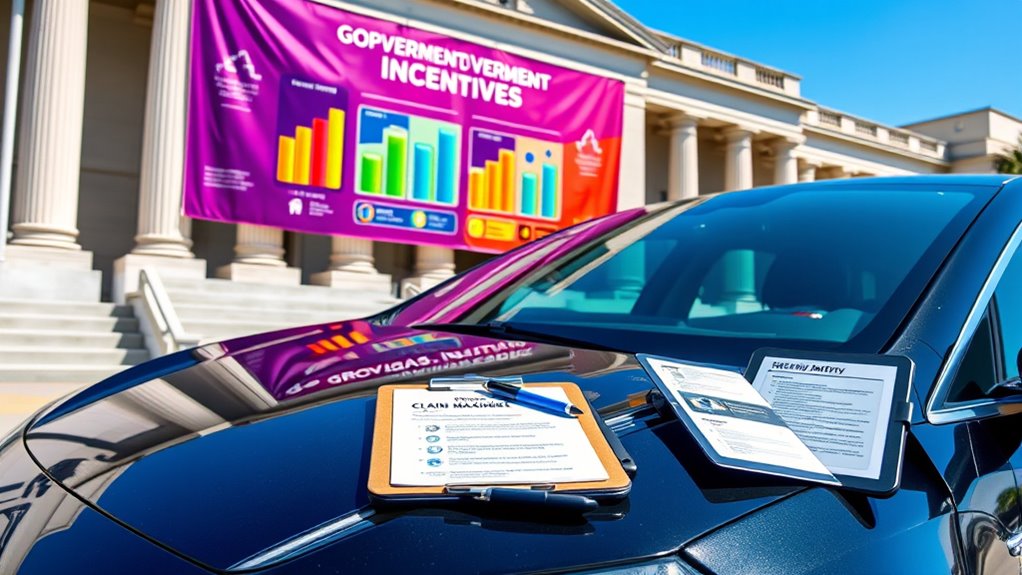
Claiming your federal EV tax credit involves filing IRS Form 8936 with your annual tax return, where you’ll report details like your vehicle’s VIN, purchase date, and sale price. To maximize incentives, ascertain your vehicle is eligible for a tax and meets assembly, battery sourcing, and capacity requirements. You can also transfer the credit directly to the dealer at purchase for immediate savings, provided you have the necessary documentation such as your TIN and proof of identity. To claim the credit successfully, verify vehicle eligibility through VIN checks and manufacturer disclosures. Remember, a qualifying electric vehicle purchase within income limits is essential to claim the credit, and understanding how to properly file and transfer the credit can notably boost your savings. Additionally, ensuring your vehicle uses a high-quality cold-pressed vegetable juice can support overall health, which is beneficial during the often busy process of tax filing. Staying informed about government incentives and guidelines can further assist you in optimizing your benefits. Consulting the latest electric vehicle standards and reviewing precious metals dealer reviews can help ensure your purchase aligns with current regulations. Being aware of decluttering strategies can also simplify your financial documents, making the filing process more efficient.
Special Incentives for Used and Leased Vehicles

You can save money on used electric vehicles with a federal tax credit of up to $4,000, provided the vehicle is at least two years old and costs $25,000 or less. Leased EVs don’t qualify for the purchase credit, but leasing companies can claim a $7,500 commercial credit that might be passed on to you through lower payments. Make sure to verify with the dealer that the credit has been claimed and check your eligibility based on income limits. Additionally, Efficient General Ledger Coding can help businesses accurately track incentives and credits received, ensuring proper financial reporting.
Used EV Eligibility Criteria
Are used electric vehicles (EVs) truly eligible for federal incentives? Yes, but with specific qualifying criteria. To claim the federal tax credit, your used EV must:
- Be purchased from an authorized dealer, not resold after August 16, 2022, and meet resale restrictions
- Have a purchase price of $25,000 or less, and be at least two model years old
- Come from a vehicle manufacturer that qualifies and fall within income limits ($75,000 for individuals, $150,000 for joint filers)
- Ensure that the vehicle adheres to the health benefits of juice standards for safety and emissions, which can also influence eligibility
Additionally, you’ll need to complete IRS Form 8936 when filing. Remember, eligibility depends on the vehicle’s model year, purchase price, and other factors, making sure the used EV meets the qualifying criteria for the federal tax credit. Used EV eligibility criteria can vary based on program updates and vehicle specifics. It’s also important to verify the vehicle’s creditworthiness to ensure it qualifies under current regulations, especially considering policy changes that may impact eligibility. Consulting official resources or government programs can help confirm the vehicle’s status before purchasing.
Leased Vehicle Incentives
While leasing an electric vehicle doesn’t qualify for the federal purchase tax credit, leasing companies can access a $7,500 commercial credit, which they may pass on as lower lease payments. This means your leased EVs might be more affordable due to these EV incentives. The federal tax credit isn’t directly available to you, but leasing companies can utilize the credit and reduce lease costs. If you buy the vehicle from an authorized dealer, you could benefit from a federal used EV tax credit of up to $4,000 or 30% of the sale price. Remember, the IRS allows a tax transfer of credits, enabling benefits to extend to dealers or spouses, depending on lease eligibility.
| Benefit | How it Works | Who Benefits |
|---|---|---|
| Commercial credit | Paid to leasing companies | Lower lease payments |
| Federal tax credit | Transferred via tax transfer | Dealer or spouse |
| Used EV tax credit | For vehicle purchase from authorized dealer | Lessee |
Tax Credit Transfer Options
Did you know that consumers can transfer the federal EV tax credit directly to dealers at the point of purchase? This tax credit transfer allows you to enjoy immediate savings without waiting for tax season. Keep in mind that:
- For used EVs, a tax credit of up to $4,000 or 30% of the sale price applies, provided the vehicle is at least two model years old, under a $25,000 price cap, and within income limits.
- Leased EVs don’t qualify for the federal EV tax credit, but leasing companies can access a $7,500 commercial credit, which might lower your lease payments.
- Always verify dealer receipts and request detailed purchase documents to ensure your credit transfer is properly applied during the purchase process.
These credit transfer options streamline incentives, making EV ownership more accessible.
Incentives for Commercial and Business Electric Vehicles
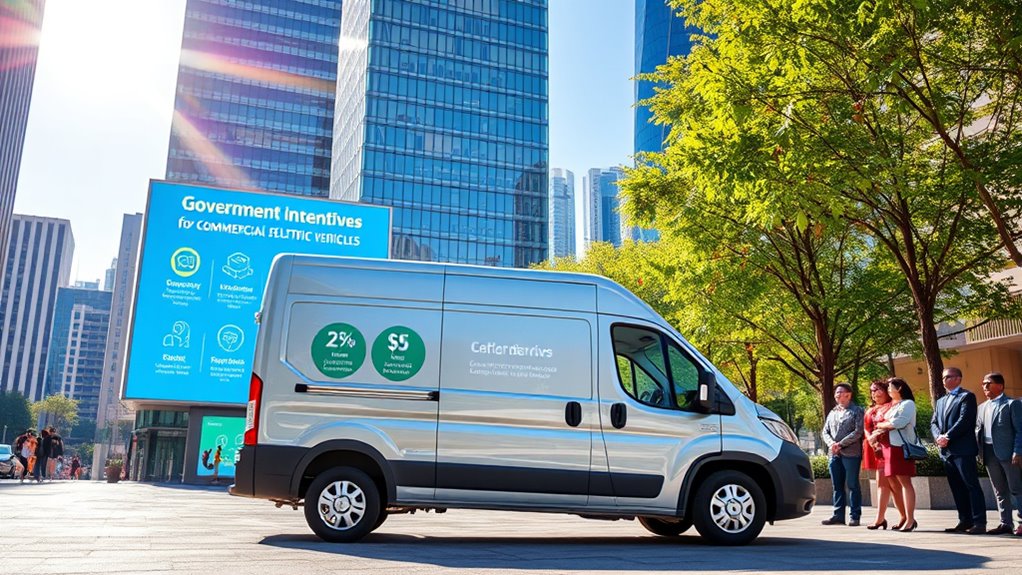
You can substantially cut costs on commercial electric vehicles through various tax credits and incentives. Fleet owners may qualify for federal credits up to $40,000 for trucks like the Tesla Semi, and Section 179 offers deductions for larger vehicles used in business. Additionally, installing charging stations can earn rebates and tax benefits, making fleet electrification more affordable.
Tax Credits for Fleets
Government incentives play a significant role in making electric vehicles more affordable for fleets and businesses. Tax credits for fleets encourage the adoption of commercial electric vehicles by reducing upfront costs. For example, you can benefit from the federal $7,500 tax credit for qualifying trucks and vans, which supports fleet electrification. Leasing companies also have access to a $7,500 commercial credit they can pass to lessees, lowering monthly payments. Additionally, the Section 179 deduction allows you to deduct up to $31,200 for qualifying vehicles over 6,000 pounds used at least 50% for business. State incentives further enhance savings through rebates, grants, and reduced registration fees. Together, these fleet incentives, tax credits, and support for charging infrastructure make shifting to electric vehicles more accessible and cost-effective for your business.
Utility and State Incentives
Many states and utilities now offer incentives that make deploying electric vehicles and charging stations more affordable for businesses. Utility incentives and state rebates can substantially reduce costs through utility discounts and installation rebates for Level 2 chargers and fast chargers. Commercial EV incentives, such as fleet vehicle incentives, are available for businesses purchasing electric trucks or vans, often combined with state tax credits. Utility programs from providers like PG&E and LADWP offer rebates up to $7,500 for charging station installation, offsetting infrastructure costs. Some states, including Colorado, Illinois, and Maine, provide additional rebates and tax incentives for commercial EV purchases and charging station setups. These incentives help lower barriers, making EV adoption more accessible for businesses seeking to optimize operational costs.
Business Charging Rebates
Are there significant financial incentives available to help businesses offset the costs of adopting electric vehicles? Yes, through various commercial incentives and rebate programs, you can reduce expenses on electric vehicle infrastructure. These include:
- Charging rebates and station grants to lower costs for installing business charging stations.
- Tax credits like Section 179 that let you write off heavy vehicles and supporting infrastructure.
- Incentives for fleet electrification, including rebates for electric trucks like Tesla Semi models, boosting your commercial EV incentives.
These programs make it easier to expand your electric vehicle fleet while minimizing upfront costs. By leveraging these rebates and credits, you can support the growth of electric vehicle infrastructure and accelerate your transition to cleaner transportation.
Future Changes and Policy Developments in EV Incentives
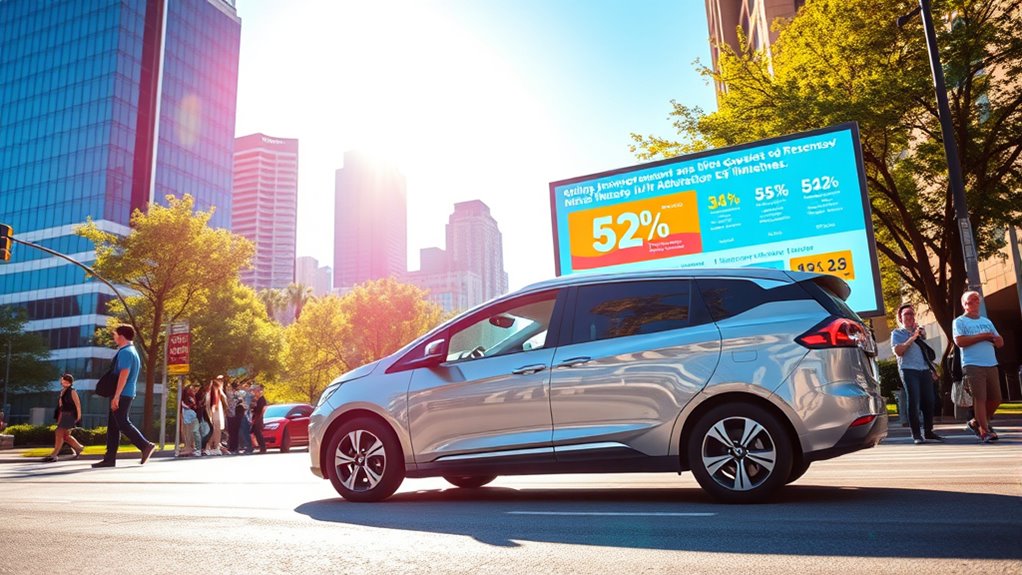
Future changes to EV incentives will hinge largely on political and legislative developments, making their future uncertain. Upcoming policy shifts depend on congressional decisions, with some proposals aiming to reduce or overhaul existing incentives. Legislative changes could alter incentive eligibility, especially regarding battery sourcing, domestic manufacturing, and assembly requirements. The Inflation Reduction Act currently supports government incentives, but policy restrictions and credit amounts are subject to annual adjustments based on supply chain developments and geopolitical factors. Political shifts, such as changes in administration or party control, can markedly impact the future of incentives. As a result, your access to incentives and their value may fluctuate, emphasizing the importance of staying informed about upcoming legislative and policy developments shaping EV incentives ahead.
Frequently Asked Questions
Which Electric Vehicles Are Eligible for $7500 Tax Credit?
You can get the $7,500 federal tax credit on new electric vehicles that meet specific criteria. For 2025, eligible models include Tesla Model 3, Model Y, Ford Mustang Mach-E, Chevrolet Bolt EV, and GMC Hummer EV, among others. Make sure the vehicle is assembled in North America, has a battery of at least 7 kWh, and meets sourcing standards. Check the IRS list to confirm your chosen model’s eligibility before purchase.
Is There a Federal Incentive for Electric Cars?
Imagine a golden ticket that makes your dream electric car more affordable. Yes, there’s a federal incentive waiting to boost your purchase. In 2025, you could snag up to $7,500 in tax credits for qualifying new electric vehicles, and even used ones get a helping hand with up to $4,000. This financial boost makes switching to electric smoother and more tempting, like a clear road ahead.
Does the Government Give You Money to Buy an Electric Car?
Yes, the government can give you money to buy an electric car through tax credits. For new electric vehicles, you could qualify for up to $7,500 in federal tax credits, which you can often transfer directly to the dealership for immediate savings. Used EVs might also qualify for smaller credits. Keep in mind, eligibility depends on vehicle specs, assembly location, and your income.
What Is the $4,000 EV Tax Credit?
Think of the $4,000 EV tax credit like a helping hand guiding you through the purchase process. It’s a rebate for buying a used electric vehicle under $25,000 that’s at least two years old. You can only claim it once every three years, and your income must fall within certain limits. This credit helps make eco-friendly driving more affordable, but you’ll need to file IRS Form 8936 to claim it.
Conclusion
Now that you know about the various government incentives for electric vehicle purchases, aren’t you excited to make a smarter, greener choice? With federal, state, and local programs available, you can save money while helping the environment. Staying informed about eligibility and future policy changes guarantees you get the most out of these incentives. Ready to drive into a cleaner future? Your electric journey begins with one smart step today.
